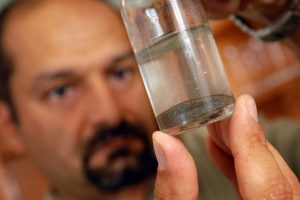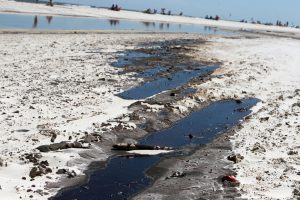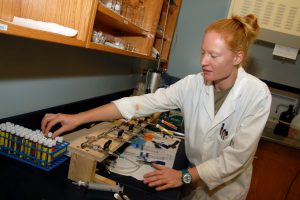By Chris Bryant
Photos by Jeff Hanson

A high-tech version of a basic principle used 8,000 years ago in reducing unwanted materials is at the heart of an effort by University of Alabama scientists to lessen the Gulf oil spill’s impact on fragile coastal marshes.
Bioremediation, a term not exactly part of the non-scientists’ every day lingo, has been around, at least in principle, since about 6000 B.C. And, it’s advancing a segment of this technology on which two UA microbiologists are focused.
Taking advantage of microorganisms’ inherent ability to reduce the unwanted – the essence of bioremediation – is at work in everything from composting, which archaeological evidence indicates was used thousands of years ago, to sewage treatment.
“This is not a new concept,” says Dr. Patricia Sobecky. However, Sobecky, professor and chair of biological sciences, and Dr. Behzad Mortazavi, her UA collaborator, are developing, along with colleagues, innovative ways to enhance bacteria’s ability to degrade oil.
The National Science Foundation awarded the pair a Rapid Response Research grant in June to explore environmental solutions for the spill.
“Before the oil has come ashore, we know that maybe 1 percent of the microbes in the salt marshes have the ability to degrade the oil,” Sobecky says. “As you have this impact of the oil coming on shore and impacting the site, you are going to have changes over time. I think what really changes the dynamic is the use of dispersant. To my knowledge, it’s never been used on this scale.”
Chemical dispersants have been distributed in huge quantities on the ocean’s surface in an attempt to break up the huge swaths of oil that have poured forth from the ocean’s floor following the late April explosion on an oil rig in the Gulf of Mexico. Oil mixed with dispersant is a more complex, and ever-changing, solution to deal with than oil alone.

The UA group, which includes Drs. Rob Martinez and Melanie Beazley, post-doctoral researchers, graduate students Rebecca Bernard and Suja Rajan and lab assistant Andrea Hale, will analyze water and marsh samples taken from marsh areas both before and after the oil arrived.
After determining which microbes show the most potential in degrading the oil, researchers will seek ways to improve those abilities through natural processes.
“This degradation of oil is a natural process,” Mortazavi said, “and the idea is to accelerate that process.”
These marsh-dwelling microbes are found naturally living on a wide variety of surfaces – referred to by scientists as substrates – including dead fish, shrimp or oysters and a variety of plants.
The project’s researchers, which include collaborators from the Lawrence Berkeley National Laboratory and the HudsonAlpha Institute, will seek to determine which of these surfaces could best serve as a booster to the microbes – acting as a multi-vitamin of sorts – sparking them to consume more of the oil.

“By looking at naturally occurring substrates, like fish, grinding those up and formulating them into a powder form to make them more available to the microbial community, could they provide enough essential nutrients that the microbes then kick into a higher gear to degrade the oil?” Mortazavi asks.
The fragileness of the marshes mean even fewer good oil cleanup options exist than are available to other contaminated areas, said Mortazavi, a biogeochemist and an assistant professor of biological sciences.
“Unlike the beach or rocky soil, the marsh ecosystems are highly sensitive to just people mucking around in there. You can’t bring a tractor in there and just scrape off the oil. You will destroy the whole system by mechanical action.
“Once the oil hits the marsh land, we don’t have many options,” he said. “One is to do nothing, and let the system naturally recover from the disaster. Another is to burn off the marsh to get rid of the oil and, obviously, you will destroy more than just the oil. A sounder approach is bioremediation.”